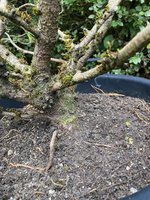Manbris
Mame
Hi all- first time posting here. A novice on pines and bonsai in general and based in the north of England.
I have several Scots and mugo pines trees from local nursery- 10-15 years old. The trunk base seemed to be buried in the pot but sure how deep.
Is it safe to dig in a couple of inches now to look for the base of the trunk? How to do it without damaging the bark? Or should I wait till spring/late winter during repot? Any advice would be appreciated.
Pics below - mugo


I have several Scots and mugo pines trees from local nursery- 10-15 years old. The trunk base seemed to be buried in the pot but sure how deep.
Is it safe to dig in a couple of inches now to look for the base of the trunk? How to do it without damaging the bark? Or should I wait till spring/late winter during repot? Any advice would be appreciated.
Pics below - mugo





